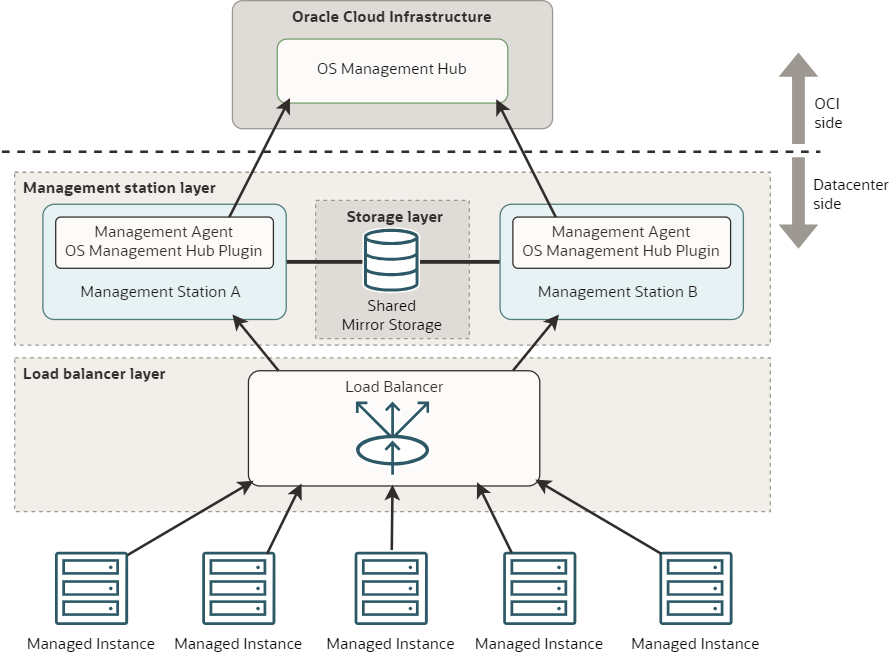Configuring High Availability for Management Stations
Configure a load balancer and multiple management stations to provide higher availability of your management stations in OS Management Hub.
Understanding High Availability
Use high availability (HA) for management stations to ensure instances can continue to receive updates from OS Management Hub in the event a management station instance fails. Individual instances connect to a load balancer which has multiple management stations configured as backends. To implement HA, there are several layers that each need to be highly available: the load balancer, management stations, and mirror storage.

To create the HA setup, configure management stations as backends to a highly-available load balancer. When you create the stations, you specify the hostname, fully-qualified domain name, or IP address of the load balancer so that managed instances communicate with the station through the load balancer.
The list of mirrored software sources for a station is built dynamically based on the profiles and instances referring to the station (see Which software sources are mirrored?). For stations in an HA configuration, the mirror list is unified across all peer stations. A profile or instance referring to one of the HA stations updates the mirror list of all the peer stations. Therefore, if one station becomes inoperable, another station can support the managed instances and keep its mirror volume synchronized.
To reduce the amount of storage required, you can configure the stations to use shared storage for the mirror. When using shared storage, the software source mirror sync status on a management station might incorrectly show as 'Unsynced'. See Known Issue: 'Unsynced' status on stations using shared storage.
Before You Begin
- Determine the networking configuration:
-
-
Identify the management station ports. All stations in an HA configuration must use the same ports:
- Proxy listening port
- Mirror listening port for HTTP
- Mirror listening port for HTTPS
- Identify the hostname or IP address for the management stations.
- Identify the hostname or IP address for the load balancer.
- Ensure the load balancer will be able to connect to the stations.
- Ensure the managed instances will be able to connect to the load balancer.
- Ensure the load balancer is in the station's permitted address range.
-
- Determine the storage configuration:
-
- Prepare the mirror storage volume to be highly available.
- Identify the storage path.
- Mount the highly-available storage volume on the storage path. For consistency, use the same mount path on all stations in the HA setup (for example
/mnt/mirror).
Setting Up High Availability for a New Environment
-
- All stations must be in the same compartment.
- All stations must use the same settings for proxy and mirror ports.
- For hostname, specify the load balancer hostname or IP address.
For example, if you have two stations:
Setting Station A Station B Name StationAStationBDescription Station in HA configStation in HA configHostname
(of load balancer)
loadbalancer.example.comloadbalancer.example.comPermitted address range 10.0.0.0/810.0.0.0/8Listening port 1608016080Storage path /mnt/mirror/mnt/mirrorMirror listening port (HTTP) 1708017080Mirror listening port (HTTPS) 1744317443 -
Configure a load balancer to route traffic from the following three ports to the management stations configured for high availability. Configure the frontend and backend for three ports:
- Proxy listening
- HTTP mirror listening port
- HTTPS mirror listening port
-
Create a profile that specifies one of the management stations.
-
Register instances using the profile you just created. Note the following exception:
When configuring the
input.rspfile in the Set Up the Management Agent section, use the load balancer hostname.For example:
cat >/tmp/input.rsp <<EOF ManagementAgentInstallKey = <MACS_KEY> Service.plugin.osmh.download = true GatewayServerHost = <LOAD_BALANCER_HOSTNAME> GatewayServerPort = <SHARED_STATION_PROXY_PORT> EOF
Reconfiguring Existing Environments for High Availability
- Reconfiguring management stations
-
-
Edit existing stations or create new stations as necessary.
- All stations must be in the same compartment.
- All stations must use the same settings for proxy and mirror ports.
- For hostname, specify the load balancer hostname or IP address.
-
Register any new management stations. If you changed proxy or mirror settings on existing stations, ensure you update the firewall and SElinux settings on the station.
-
Configure a load balancer to route traffic from the following three ports to the management stations configured for high availability. Configure the frontend and backend for three ports:
- Proxy listening
- HTTP mirror listening port
- HTTPS mirror listening port
-
- Reconfiguring instances
-
- Identify existing instances that you want in the HA configuration.
- On each managed instance, switch the management station to point to one of the HA stations.
- Ensure you run the
instance-setup.shscript to update the hostname and proxy information.